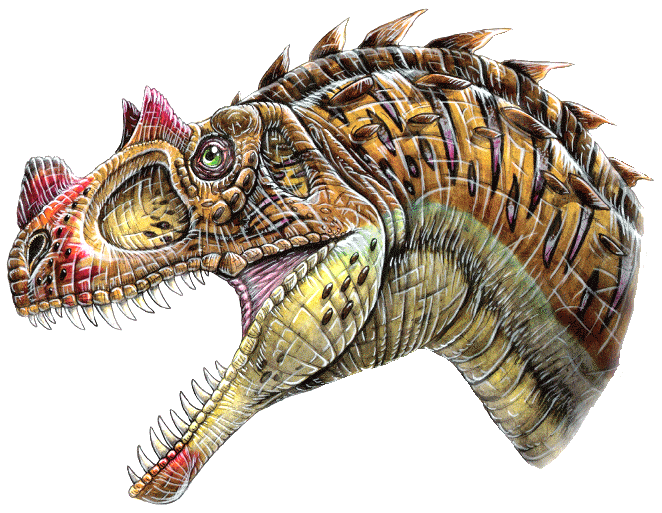Post by Deinobrontornis on Dec 6, 2011 16:34:31 GMT -5
Mandrill - Mandrillus sphinx

The mandrill (Mandrillus sphinx) is a primate of the Old World monkey (Cercopithecidae) family, closely related to the baboons and even more closely to the drill.
The mandrill is perhaps the most colorful primate. It has an olive green or dark grey pelage with yellow and black bands and a white belly. Its hairless face has an elongated muzzle with distinctive characteristics such as a red stripe down the middle and protruding blue ridges on the sides. It also has red nostrils and lips, a yellow beard and white tuffs. The areas around the genitals and the anus are multi-colored, being colored red, pink, blue, scarlet, and purple. They also have pale pink ischial callosities. The coloration of the animal is more pronounced in dominant adult males. Both sexes have a patch of skin, surrounded by bristly hairs, on their chests that are used in olfactory communication. These, too, are more pronounced in dominant adult males. Males also have longer canines than females, with an average of 4.5 cm (1.8 in) and 1.0 cm (0.39 in), respectively.
Males average 25–35 kg (55-77 lb), females are less than half that weight (11–14 kg, or 25-30 lb). Unusually large males can weigh 50 kg (110 lb). The average male is 81–90 cm (32–36 in) and the female is 56–66 cm (22–26 in), with the tail adding another 5–8 cm (2–3 in). They can survive up to 31 years in captivity.
African Wild Dog - Lycaon pictus

Lycaon pictus is a large canid found only in Africa, especially in savannas and lightly wooded areas. It is variously called the African wild dog, African hunting dog, Cape hunting dog, painted dog, painted wolf, painted hunting dog, spotted dog, or ornate wolf.
Adults typically weigh 18–36 kilograms (40–79 lb). A tall, lean animal, it stands about 75 cm (30 in) at the shoulder, with a head and body length of 75–141 cm (30–56 in) plus a tail of 30 to 45 cm (12 to 18 in). Animals in southern Africa are generally larger than those in eastern or western Africa. It is the only canid species to lack dewclaws on the forelimbs.
It has a dental formula of
3.1.4.2 / 3.1.4.3
for a total of 42 teeth. The premolars are relatively large compared with those of other canids, allowing it to consume a large quantity of bone, much like the hyena. The heel of the lower carnassial M1 is crested with a single cusp, which enhances the shearing capacity of teeth and thus the speed at which prey can be consumed. This feature is called trenchant heel and is shared with two other canids: the Asian dhole and the South American bush dog.
The African wild dog has a bite force quotient (BFQ, the strength of bite relative to the animal's mass) measured at 142, the highest of any extant mammal of the order Carnivora, although exceeded by the Tasmanian devil, a marsupial carnivore.

The mandrill (Mandrillus sphinx) is a primate of the Old World monkey (Cercopithecidae) family, closely related to the baboons and even more closely to the drill.
The mandrill is perhaps the most colorful primate. It has an olive green or dark grey pelage with yellow and black bands and a white belly. Its hairless face has an elongated muzzle with distinctive characteristics such as a red stripe down the middle and protruding blue ridges on the sides. It also has red nostrils and lips, a yellow beard and white tuffs. The areas around the genitals and the anus are multi-colored, being colored red, pink, blue, scarlet, and purple. They also have pale pink ischial callosities. The coloration of the animal is more pronounced in dominant adult males. Both sexes have a patch of skin, surrounded by bristly hairs, on their chests that are used in olfactory communication. These, too, are more pronounced in dominant adult males. Males also have longer canines than females, with an average of 4.5 cm (1.8 in) and 1.0 cm (0.39 in), respectively.
Males average 25–35 kg (55-77 lb), females are less than half that weight (11–14 kg, or 25-30 lb). Unusually large males can weigh 50 kg (110 lb). The average male is 81–90 cm (32–36 in) and the female is 56–66 cm (22–26 in), with the tail adding another 5–8 cm (2–3 in). They can survive up to 31 years in captivity.
African Wild Dog - Lycaon pictus

Lycaon pictus is a large canid found only in Africa, especially in savannas and lightly wooded areas. It is variously called the African wild dog, African hunting dog, Cape hunting dog, painted dog, painted wolf, painted hunting dog, spotted dog, or ornate wolf.
Adults typically weigh 18–36 kilograms (40–79 lb). A tall, lean animal, it stands about 75 cm (30 in) at the shoulder, with a head and body length of 75–141 cm (30–56 in) plus a tail of 30 to 45 cm (12 to 18 in). Animals in southern Africa are generally larger than those in eastern or western Africa. It is the only canid species to lack dewclaws on the forelimbs.
It has a dental formula of
3.1.4.2 / 3.1.4.3
for a total of 42 teeth. The premolars are relatively large compared with those of other canids, allowing it to consume a large quantity of bone, much like the hyena. The heel of the lower carnassial M1 is crested with a single cusp, which enhances the shearing capacity of teeth and thus the speed at which prey can be consumed. This feature is called trenchant heel and is shared with two other canids: the Asian dhole and the South American bush dog.
The African wild dog has a bite force quotient (BFQ, the strength of bite relative to the animal's mass) measured at 142, the highest of any extant mammal of the order Carnivora, although exceeded by the Tasmanian devil, a marsupial carnivore.















